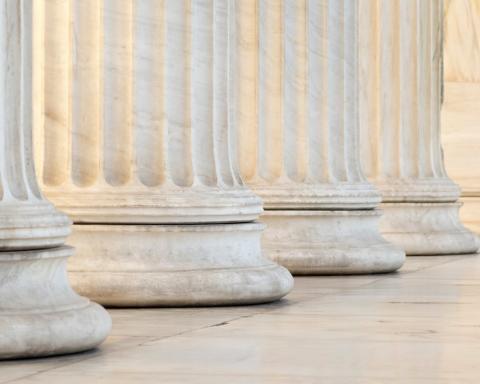Written by Attorney Lillian Grappe Lamphere for the Summer 2021 Edition of Powerhouse Points, A Quarterly Litigation Update.
Read the full issue here.
Powerhouse Points:
- In-person proceedings in many courts remain canceled or postponed with courts continuing to rely on virtual proceedings as a substitute.
- Virtual testimony is not an equivalent substitute for live, in-person testimony.
- Procedural rules allow courts to accept testimony by contemporaneous remote transmission for good cause in compelling circumstances, provided appropriate safeguards are in place.
- There have been significant advancements in managing the threat of COVID-19, which may be shifting the “good cause” analysis.
- How should litigators, as client advocates, respond to opponents continued preferences for virtual trial and deposition testimony?
In many ways, America seems to be turning a real corner in the COVID-19 pandemic, which has significantly altered our lives over the past year. Indeed, with the widespread availability of vaccines, people have begun returning to normal activities such as air travel, in-office working, weddings, and even shaking hands. However, for attorneys in some parts of the country, practice remains anything but “normal.”
In-person jury trials in many courts across the country remain canceled or postponed with courts turning to virtual hearings and (in some cases) trials as a substitute[1] . While such accommodations were widely granted over the past year, a debate as to the sufficiency of such remote testimony has arisen[2]. Of course, virtual testimony is not an equivalent substitute for live, in-person testimony[3] . In fact, both the legal and scientific communities recognize the shortcomings of virtual testimony, particularly for direct and cross-examination of witnesses.
While Federal Rule of Civil Procedure 43(a) and similar state court procedural rules allow courts to accept testimony by contemporaneous remote transmission for good cause in compelling circumstances, provided appropriate safeguards are in place, this practice is an exception to the general rule that that “[i]n every trial, the testimony of witnesses shall be taken in open court.”[4] In fact, the advisory committee’s notes on the 1996 amendments to Federal Rule of Civil Procedure 43 make clear that, “The importance of presenting live testimony in court cannot be forgotten. The very ceremony of trial and the presence of the fact-finder may exert a powerful force for truth telling. The opportunity to judge the demeanor of a witness face-to-face is accorded great value in our tradition.”[5] State courts have likewise recognized that “it [is] important for the integrity of the process for the parties to present live, in person testimony.”[6] Moreover, peer-reviewed scientific studies have found that remote testimony can affect the fact finder’s witness credibility determination and perceptions[7]. In addition to the disadvantages remote testimony places on the tribunal, virtual testimony arguably deprives the adverse party of its due process right to confront a witness through cross-examination[8] . Given these inadequacies of virtual testimony, “remote transmission is to be the exception and not the rule[.]”[9] Yet, the opposite has proved true over the last year and a half (and with good reason).
First, it need not be an all or nothing equation. Courtrooms across the country have come up with creative solutions to prevent disease spread such as installation of plexiglass barriers, HEPA filters, limiting public attendance, transparent face shields, juror COVID testing, and social distancing procedures.[10] In fact, with the proper precautions, in-person jury trials have proceeded with success during the pandemic and improved conditions would seem to further encourage their return.[11] Litigants seeking to hold in-person proceedings could address their opponents’ safety concerns with the promise of limited attendance, covering the costs of outfitting the tribunal with safety equipment, and abiding by social distancing and/or testing procedures. Should such overtures prove unfruitful, one alternative recently proposed by counsel in the United States District Court for the Southern District of New York is to require individuals seeking to avoid in-person trial testimony to disclose their vaccination status to the tribunal.[12] Because vaccinated individuals are at low risk of contracting and transmitting COVID-19 infections, litigants could file motions with the court requesting their opponent demonstrate why they should be denied in-person, socially-distanced testimony. To protect the parties’ and attorneys’ privacy interests, litigators could offer to submit proof of vaccination status for in camera review to the tribunal.
Given the importance of live testimony, the improving COVID-19 conditions, and opening trends across the country, perhaps it is time for attorneys to re-evaluate whether virtual testimony remains necessary in all circumstances.
[1] Federal Courts Respond to Covid-19: Live Map, Bloomberg Law, https://news.bloomberglaw.com/us-law-week/arguments-axed-access-limited-courts-respond-to-covid-19-map (last visited Jun. 14, 2021); Justia, Court Operations During COVID-19: 50-State Resources, https://www.justia.com/covid-19/50-state-covid-19-resources/court-operations-during-covid-19-50-state-resources/ (last visited Jun. 14, 2021); Christopher Green and Sara Fish, Law360, Weighing The Virtual Courtroom Option in Civil Cases (Aug. 19, 2020, 4:45 PM), https://www.law360.com/articles/1302546/weighing-the-virtual-courtroom-option-in-civil-cases; Meghann Cuniff, Judges differ on when it's safe to hold in-person jury trials, ABAJournal (February 1, 2021, 3:35 AM), https://www.abajournal.com/magazine/article/judges-differ-on-when-its-safe-to-hold-in-person-jury-trials (“No national policies exist regarding in-person proceedings, resulting in vastly different approaches to jury trials during the pandemic.”).
[2] Norma C. Izzo, How Litigators Are Confronting COVID in the Courtroom (August 31, 2020), https://www.americanbar.org/groups/litigation/committees/trial-practice/articles/2020/covid-19-video-testimony-courtrooms/.
[3] U.S. v. Lawrence, 248 F.3d 300, 304 (4th Cir. 2001) (“[V]irtual reality is rarely a substitute for actual presence and that, even in an age of advancing technology, watching an event on the screen remains less than the complete equivalent of actually attending it.”).
[4] Fed. R. Civ. P. 43(a); see Wis. Stat. § 807.13(2).
[5] Fed. R. Civ. P. 43 advisory committee’s notes to 1996 amendment; see also Stoner v. Sowders, 997 F.2d 209, 213 (6th Cir. 1993) (“[T]he jury and the judge never actually see the witness. The witness is not confronted in the courtroom situation. The immediacy of a living person is lost. In the most important affairs of life, people approach each other in person, and television is no substitute for direct personal contact.”).
[6] In re Shaianne D., 2012 WI App 118, ¶ 18, 344 Wis. 2d 521, 822 N.W.2d 737; see, e.g., Kelly v. Kelly, 445 S.W.3d 685, 694 (Tenn. 2014) (“There are important reasons why live, in-person testimony is more desirable than remote testimony” and listing frequently cited reasons).
[7] Sara Landström, Children’s truthful and deceptive testimonies: How camera perspective affects adult observers’ perception and assessment, 14 Psych., Crime & Law 5 (2008), https://www.tandfonline.com/doi/abs/10.1080/10683160701580107?src=recsys&journalCode=gpcl20&; Sara Landström, Witnesses appearing live versus on video: effects on observers' perception, veracity assessments and memory, 19 Applied Cognitive Psych. 7 (2005), https://onlinelibrary.wiley.com/doi/abs/10.1002/acp.1131; Alicia Bannon and Janna Adelstein, The Impact of Video Proceedings on Fairness and Access to Justice in Court, Brennan Center for Justice (Sept. 10, 2020) https://www.brennancenter.org/our-work/research-reports/impact-video-proceedings-fairness-and-access-justice-court (collecting and summarizing existing scholarship on the effects of video technology in court proceedings).
[8] Union Auto. Indem. Ass’n v. Capitol Indem. Ins. Co., 310 F.2d 318, 321 (7th Cir. 1962); In re Shaianne D., 2012 WI App 118, ¶ 18 (denying a party’s request to permit remote testimony at trial, explaining “[remote testimony] would not ensure that all of the due process rights of all of the litigants are properly observed”); see Greene v. McElroy, 360 U.S. 474, 496 (1959) (noting in-person cross-examination is particularly necessary “where the evidence consists of the testimony of individuals whose memory might be faulty or who, in fact, might be perjurers or persons motivated by malice, vindictiveness, intolerance, prejudice, or jealousy”).
[9] Fed. R. Civ. P. 43(a); Lopez v. NTI, LLC, 748 F. Supp. 2d 471, 479 (D. Md. 2010) (citing Fed. R. Civ. P. 43(a)).
[10] Matt Reynolds, 6 tips from infectious disease experts for in-person court proceedings, ABAJournal (Feb. 23, 2021, 12:57 PM), https://www.abajournal.com/web/article/six-tips-from-infectious-disease-experts-for-in-person-court-proceedings.
[11] Christian Nolan, The Verdict Is In…What an In-Person Trial Is Like During COVID-19, New York State Bar Association (November 17, 2020), https://nysba.org/the-verdict-is-inwhat-an-in-person-trial-is-like-during-covid-19/; Meghann Cuniff, supra note 1 (“Despite reports from federal courts of in-person jury trials being held safely, many judges across the country are still deliberating whether to hold in-person jury trials at all.”).
[12] Debra Cassens Weiss, Reluctant trial witnesses should disclose vaccination status to judge, motion says, ABA Journal (Mar. 31, 2021, 12:15 PM), https://www.abajournal.com/news/article/reluctant-trial-witnesses-should-disclose-vaccination-status-to-judge-motion-says.









